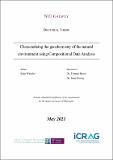| dc.description.abstract | The geochemistry of the natural environment (e.g. soils, streams, sediments and groundwater)
is representative of the source(s) from which these materials are derived. In fact, a geochemical
dataset is essentially a breakdown of the parts that together form the composition of materials.
As pointed out by Pearson (1897), spurious correlation can occur when attempting multivariate
analysis on a dataset that is compositional in nature (i.e. the variables are measured as parts of
some whole e.g. mg/l). Compositional Data Analysis (CoDA) was developed by John
Aitchison (1982) and others to solve this issue, and is therefore the correct mathematical
framework by which to statistically analyse these types of data. CoDA also allows for a unique
interrogation of compositional data primarily through the use of the multi-dimensional
compositional bi-plot.
CoDA methods have been used extensively here, and in some cases compared to traditional
multivariate statistical methods, in order to better understand the relationship between
geochemistry and the natural environment on a variety of temporal and spatial scales.
Specifically, two studies were undertaken; i) the geochemistry of groundwater in the area
surrounding Lisheen Mine in Co. Tipperary, Ireland, and ii) the geochemistry of soils, stream
sediments and stream waters in the border region of Ireland.
Geochemistry datasets from Lisheen Mine offer a unique opportunity to investigate the
chemical nature groundwater in an area prior to, during and following significant mining
activity. Overall it would appear that the local groundwater was relatively un-impacted by the
excavation of lead/zinc massive sulphides over a 16 year period (1999 – 2015). This may be in
part thanks to the buffering effect of the host Carboniferous Limestone reducing the potential
for acid mine drainage. Groundwater chemistry in the area appears to be more influenced by
nitrogen from peat bogs, local agricultural practices and in some places redox reactions.
The border region (composed of the six counties that border Northern Ireland) was the subject
of an extensive geochemical examination by the Tellus Survey completed in 2013. The
resulting freely available datasets were analysed here using CoDA. The primary, secondary
and tertiary factors controlling soil, sediment and stream water geochemistry were determined.
The dominant control on each of these materials is bedrock geology. However, soil type, landuse
practices and topography also influence geochemistry. | en_IE |


